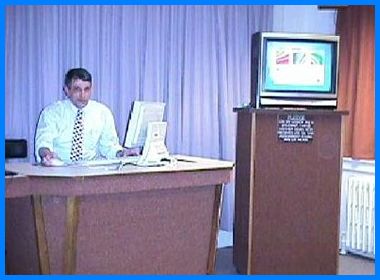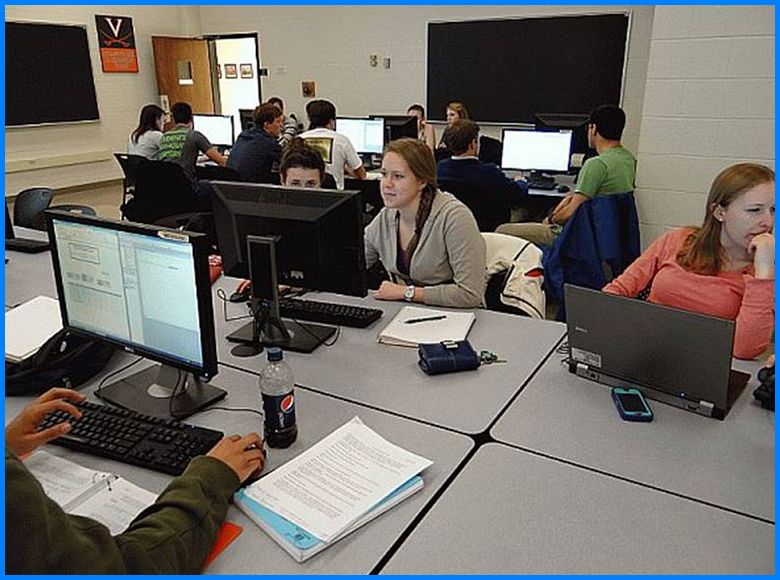The developers tailored the algorithms and interfaces for each of these ten modules uniquely for the particular application. This approach avoids the frequently-steep learning curves associated with much more powerful, commercially available CFD packages. In most cases the author used specific techniques derived from his own research and teaching. Some sixty university students taking undergraduate Heat and Mass Transfer during the Spring 1996 semester used these modules extensively for the first time. Subsequent classes used them sixteen more times in the Spring 1997-2013 semesters. Since then we have enhanced all modules continuously and extensively as a result of these experiences.
Development
We developed many of the original Fortran programs as demonstrations and assignments in distance education courses in Computational Fluid Dynamics and Heat Transfer. We taught this and other courses multiple times through the Virginia Commonwealth Graduate Engineering Program (now known as Cardinal Education).

Then as facilities became available, we used them in a similar mode in a projector-equipped, local classroom. The development of the graphical-user-interfaces during the 1995-96 academic year as part of the UVA Teaching + Technology Initiative made them appropriate for student use as well Students can use them on their own, or as we use them, in a scheduled “studio” session. Students attend two 50-minute-long, traditional classes a week, but also have a two-hour working session in one of our computer classrooms.
We used Watcom Fortran 77 originally for the intense numerical computations and for generation of the color plots. We employed a tailored Visual Basic executable for the user interface. Later we ported all modules to Visual Basic 6, allowing for much more interactivity than in the past. Now in the 21st century all modules are written in VB 2013. They have been installed and tested in the “cloud.”

Challenges
Developing the underlying computational routines, the user-interface, on-line help file, the supporting documentation, student exercises and assessment tools, and in many cases a journal article is extremely time-consuming. That being the case, we selected the topics for stand-alone modules with great care. We developed modules only for topics that take at least ten pages in a typical textbook. In several cases a single module illustrates all the concepts from a whole chapter in a graduate-level text. In addition, several of the modules are sufficiently general that they may be used in related STEM courses. We created Excel workbooks to cover other topics that might take up a textbook page or two.
The interested reader may view a more detailed PowerPoint presentation detailing the evolution of this software and its application in instruction here.
Acknowledgment
General References
Ribando, R.J., Heat Transfer Tools, McGraw-Hill, NY, 2002.
Ribando, R.J., Richards, L.G., and O’Leary,G.W., “A “Hands-On” Approach to Teaching Undergraduate Heat Transfer,” Symposium on Mechanical Engineering Education, Paper IMECE2004-61165, ASME IMECE ’04, Anaheim, CA, Nov. 14-19, 2004.
Ribando, R.J., Scott, T.C., Richards, L.G. and O’Leary, G.W., “Using Software with Visualization to Teach Heat Transfer Concepts,” Paper # 2002-1536, Proceedings of the ASEE Annual Conference and Exposition, Montreal, Canada, June 16-19,2002.
Ribando, R.J., Scott, T.C., and O’Leary, G.W., “Application of the Studio Model to Teaching Heat Transfer,” Proceedings of the 2001 American Society for Engineering Education Annual Conference & Exposition, Albuquerque, NM.
Ribando, R.J., Scott, T.C. and O’Leary, G.W., “Teaching Heat Transfer in a Studio Mode,” Session on Energy Systems Education, 1999 ASME IMECE, Nashville, TN, HTD – Vol. 364-4, Edited by L.C.Witte, Nov. 1999, pp. 397-407.
Ribando, R.J., “Teaching Modules for Heat Transfer,” Workshop on Advanced Technology for Engineering Education, Feb. 24-25, 1998, Peninsula Graduate Center, Hampton, VA. NASA/CP-1998-208442, Edited by A.K.Noor and J.B.Malone, pp. 239-259.
Ribando, R.J. and O’Leary, G.W., “Teaching Modules for Heat Transfer,” ASME Proceedings of the 32nd National Heat Transfer Conference, HTD-Vol.344, Volume 6, Innovations in Heat Transfer Education, pp. 75-82, August 1997.
